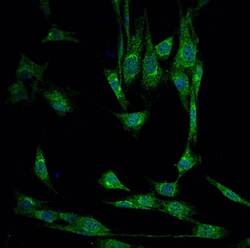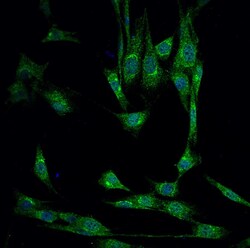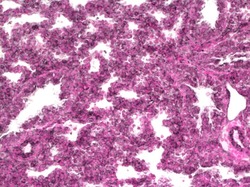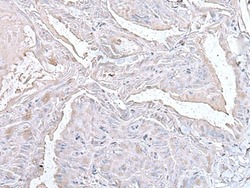Antibody data
- Antibody Data
- Antigen structure
- References [0]
- Comments [0]
- Validations
- Immunocytochemistry [2]
- Immunohistochemistry [2]
Submit
Validation data
Reference
Comment
Report error
- Product number
- PA5-67528 - Provider product page

- Provider
- Invitrogen Antibodies
- Product name
- PRL1 Polyclonal Antibody
- Antibody type
- Polyclonal
- Antigen
- Other
- Description
- Predicted to react with Mouse and Rat samples.
- Reactivity
- Human, Mouse, Rat
- Host
- Rabbit
- Isotype
- IgG
- Vial size
- 100 μL
- Concentration
- 1 mg/mL
- Storage
- -20°C
No comments: Submit comment
Supportive validation
- Submitted by
- Invitrogen Antibodies (provider)
- Main image

- Experimental details
- Immunofluorescence analysis of PRL1 in NIH3T3 cells fixed with 4% PFA, permeabilized with 0.2% Triton X-100 and stained with polyclonal PRL1 antibody (Product # PA5-67528) at 1:40. Cells were co-stained with DAPI (blue). Data courtesy of Dr. Xiaofang Tang at Cincinnati Children's Hospital Medical Center.
- Submitted by
- Invitrogen Antibodies (provider)
- Main image

- Experimental details
- Immunofluorescence analysis of PRL1 in NIH3T3 cells fixed with 4% PFA, permeabilized with 0.2% Triton X-100 and stained with polyclonal PRL1 antibody (Product # PA5-67528) at 1:40. Cells were co-stained with DAPI (blue). Data courtesy of Dr. Xiaofang Tang at Cincinnati Children's Hospital Medical Center.
Supportive validation
- Submitted by
- Invitrogen Antibodies (provider)
- Main image

- Experimental details
- Immunohistochemistry analysis of PRL1 in paraffin-embedded frozen mouse E18.5 lung sections. Antigen retrieval was done with citrate buffer (pH 6.0). Sections were blocked and probed with a polyclonal PRL1 antibody (Product # PA5-67528) at a dilution of 1:100. Staining shows positive cytoplasmic signals. Data courtesy of Dr. Xiaofang Tang at Cincinnati Children's Hospital Medical Center.
- Submitted by
- Invitrogen Antibodies (provider)
- Main image

- Experimental details
- Immunohistochemical analysis of PRL1 in paraffin-embedded Human thyroid cancer tissue using (left) PRL1 Polyclonal Antibody (Product # PA5-67528) at a 1:40 dilution and (right) is treated with fusion protein. (Original magnification: x200).
 Explore
Explore Validate
Validate Learn
Learn Western blot
Western blot Immunocytochemistry
Immunocytochemistry